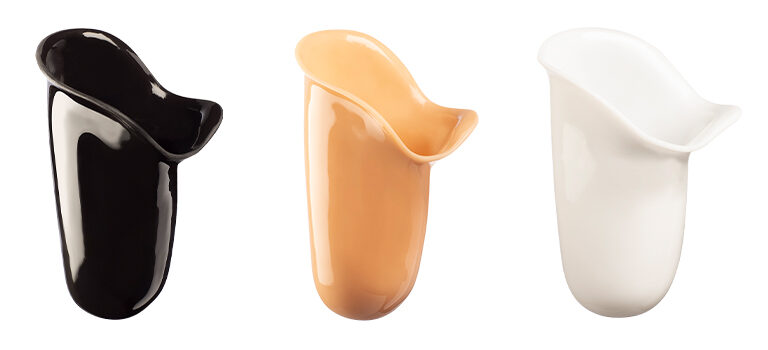
Which Orthotic and Prosthetic Fabrication Material Should You Use?
Overview of all Orfitrans Thermoplastic Products
With so many orthotic and prosthetic fabrication materials to choose from, you may wonder which one is most suitable for your patient’s needs. But we’ve got you covered! Here’s an overview of all Orfitrans thermoplastic products and their most important characteristics.
Orfitrans thermoplastics all pull easily and uniformly and are simple to mold. They have a low shrinkage rate with no risk for excessive pressure or compression; the materials will keep the shape and dimensions determined by the model. But, of course, there’s a lot more to take into account when choosing a suitable material.
The Orfitrans family of products contains many different colors, thicknesses, and physical attributes. It is important to understand the product properties to make appropriate selections for orthotic or prosthetic device fabrication.
Overview
Here are specifications about the various Orfitrans products that will help you select the right product for your next O&P device. We provide recommended uses and fabrication techniques, product attributes, as well as colors and thickness options. The orthotic and prosthetic fabrication materials are listed from stiffest to softest in each category of this article.
We divided the materials into the following three categories:
.
Test Sockets
Orfitrans PETG
Use: Short-term prosthetic test sockets
Recommended fabrication method: Bubble forming
Thermoplastic type: PETG base
Available thicknesses: 8 mm, 10 mm, 12 mm, 15 mm and 20 mm (5/16”, 3/8”, 1/2”, 19/32” and 3/4”)
Benefits and characteristics: PETG stands out for its exceptional strength for the fabrication of test sockets — no cracking, no breaking! Crucially, it prioritizes patient safety. Thanks to the dedicated, upheld and cleaner production line, the new PETG now features a crystal clear color and enhanced durability, while retaining the same strenght as the previous version.
 Orfitrans Stiff
Orfitrans Stiff
Use: Long-term prosthetic test sockets
Recommended fabrication method: Bubble forming
Thermoplastic type: Styrene base
Available thicknesses: 8 mm, 10 mm, 12 mm, and 15 mm (5/16”, 3/8”, 1/2”, and 19/32”)
Benefits and characteristics: This material is virtually indestructible, yet easy to drill into or modify. With a high impact resistance, Orfitrans Stiff will not break, crack, or shatter when dropped. The socket will remain transparent with a slight blue tint that will allow the limb to remain visible. The working properties of Orfitrans Stiff include a non-sticky exterior.
.
Inner Socket Materials
.
Orfitrans Excel
Use: Inner prosthetic sockets
Recommended fabrication method: Bubble and drape forming
Thermoplastic type: PE Copolymer base (comparable to EVA-based products)
Color options: Black and semi-transparent (almost clear)
Available thicknesses:
– Orfitrans Excel Black: 3 mm, 5 mm, 8 mm, 10 mm, 12 mm, and 15 mm (5/16”, 3/8”, 1/2”, and 19/32”)
– Orfitrans Excel Semi-Transparent: 3 mm, 5 mm, 8 mm, 10 mm, 12 mm and 15 mm (1/8”, 5/32”, 13/64”, 5/16”, 3/8”, 1/2”, and 19/32”)
Benefits and characteristics: Orfitrans Excel is a flexible material that provides a surface finish that is silky and smooth. This thermoplastic has a self-adhesive property and will bond permanently to itself. Correction of shape is possible as this thermoplastic can be reheated and remolded allowing easy relief of pressure points. Orfitrans Excel is 8% lighter than other competitive EVA-type products; this lighter weight makes the product wear more comfortable. The transparency of the semi-transparent color offers observation of anatomy while being worn; it allows monitoring of potential pressure areas; and it allows control to ensure total surface contact. Furthermore, Orfitrans Excel has excellent U.V. stability which means that it has no yellowing, and it is not susceptible to aging under normal storage conditions. Orfitrans Excel is a great alternative to Orfitrans Medium Soft.

Orfitrans Extra Soft
Use: Inner prosthetic sockets (upper and lower extremity)
Recommended fabrication method: Bubble forming
Thermoplastic type: EVA base
Color options: Beige and natural (which is a semi-transparent whitish color)
Available thicknesses:
– Orfitrans Extra Soft Natural: 9 mm and 12 mm (23/64”, and 1/2”)
Benefits and characteristics: Very flexible prosthetic fabrication materials that are extremely smooth with no tacky or sticky feel. Orfitrans Extra Soft offers outstanding patient comfort.
 Orfitrans Extra Soft Silicone
Orfitrans Extra Soft Silicone
Use: Inner prosthetic sockets
Recommended fabrication method: Bubble forming
Thermoplastic type: EVA base
Color options: Natural (which is an opaque whitish color; the whitest of all the Orfitrans products)
Available thicknesses: 9 mm and 12 mm (23/64”, and 1/2”)
Benefits and characteristics: Just like its cousin discussed above, Orfitrans Extra Soft Silicone is a very flexible material that is extremely smooth with no tacky or sticky feel and offers an outstanding patient comfort. Thanks to the silicone, this product prevents the need for powder on the inside and it eliminates all the difficulties and inconveniences often experienced in donning and doffing other socket materials.
Orthotic Materials
 Orfitrans Excel
Orfitrans Excel
Use: Hand, wrist, and ankle lining orthoses
Recommended fabrication method: Drape forming
Thermoplastic type: PE Copolymer base (comparable to EVA-based products)”
Color options: Black and semi-transparent (almost clear)
Available thicknesses:
– Orfitrans Excel Black: 3 mm, 5 mm, 8 mm, 10 mm, 12 mm, and 15 mm (5/16”, 3/8”, 1/2”, and 19/32”)
– Orfitrans Excel Semi-Transparent: 3 mm, 4 mm, 5 mm, 8 mm, 10 mm, 12 mm and 15 mm (1/8”, 5/32”, 13/64”, 5/16”, 3/8”, 1/2”, and 19/32”)
Benefits and characteristics: In addition to the characteristics of Orfitrans Excel we described earlier, the main benefit for orthotics is that Orfitrans Excel can be drape formed. This is thanks to its self-adhesive properties and ability to bond permanently to itself.
Learn more
To learn more about Orfitrans products, visit our Orfit Academy, Orthotic and Prosthetic Institute where we have an overview course relating to all Orfitrans orthotic and prosthetic fabrication materials.
If you have any questions about product selection for your next orthotic or prosthetic device, please feel free to contact us.
If you’d like to receive the latest product updates and interesting Orfit news, subscribe to our newsletter:





